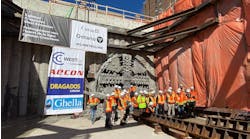In a town where the biggest annual event is a festival called Railroad Days, the train station is a pretty important place.
So when Amtrak spends $2.5 million creating a modern platform where Selma passengers can get on and off the trains, it’s cause for celebration.
The new 325-foot platform brings Selma-Smithfield Union Depot into compliance with the Americans With Disabilities Act. It’s wider and higher, making it easier to reach the stairs of a train car. There’s new lighting and fencing and yellow reflective markings and a bubbled surface to indicate where people should and shouldn’t stand when a train comes in.
“It is an improvement in every way from what was here before,” Mayor Byron McAllister said in an interview. “What we had here before, quite frankly, was an old-school sidewalk. This is a platform.”
McAllister was speaking Wednesday after a ceremony organized by Amtrak to mark completion of the project, part of a national effort to make all its passenger stations fully accessible to everyone. Jason Orthner, who heads the N.C. Department of Transportation’s Rail Division, said the modern platforms are easier for everyone to navigate and make boarding more efficient.
“I like to run trains on time,” Orthner said. “So the faster we can get people on and off the trains, the better we are. Very important to us.”
There are 525 stations along Amtrak’s national network, and the railroad is responsible for ADA compliance at 387 of them, said David Handera, the railroad’s vice president. Of those, 118 are compliant and 65 need work on their passenger platforms, including stations in Rocky Mount, Hamlet and Fayetteville, Handera said.
Six other Amtrak-controlled stations in North Carolina, including Durham, fully meet ADA accessibility standards, Handera said.
“We’ve invested $850 million to date making our stations compliant,” he said. “We have a long way to go.”
The Selma platform is considered ADA compliant even though passengers still need to climb up or down the steps of the train cars. That’s because of a special provision in the law for train stations on tracks that are also used by freight trains.
Only one Amtrak station in North Carolina, Raleigh Union Station, has level boarding where passengers can walk on and off without steps. That’s because the tracks in Raleigh are on a siding away from freight trains. At all other stations, the platforms must be no higher than 8 inches above the rails so they don’t interfere with freight cars.
Handera noted that Amtrak has ordered new train cars that will have on-board lifts for passengers who cannot use stairs. Those cars should begin to appear in North Carolina in the next couple of years, he said.
A railroad town from the beginning
Selma was born and grew up around a stop on the North Carolina Railroad in the late 19th century. The current brick station, built in 1924 at the spot where the N.C. Railroad tracks crossed what was then the Atlantic Coast Line Railroad, was nearly demolished in the mid-1970s after passenger trains no longer stopped there.
But residents fought to save the station and persuaded the town to take it over. The building housed a small museum for a while and was the focus of the first Railroad Days celebration in 1976.
Amtrak brought train service back to Selma in the 1980s, starting with the Palmetto between New York City and Savannah, Georgia, and then the Carolinian, the state-subsidized train that runs between Charlotte and the Northeast.
Having four trains a day stopping in town is more than just convenient for Johnston County travelers, McAllister said.
“It is in our DNA,” he said. “It is our history. We cannot overstate the importance of rail in Selma, North Carolina.”
©2024 Raleigh News & Observer. Visit newsobserver.com. Distributed by Tribune Content Agency, LLC.

